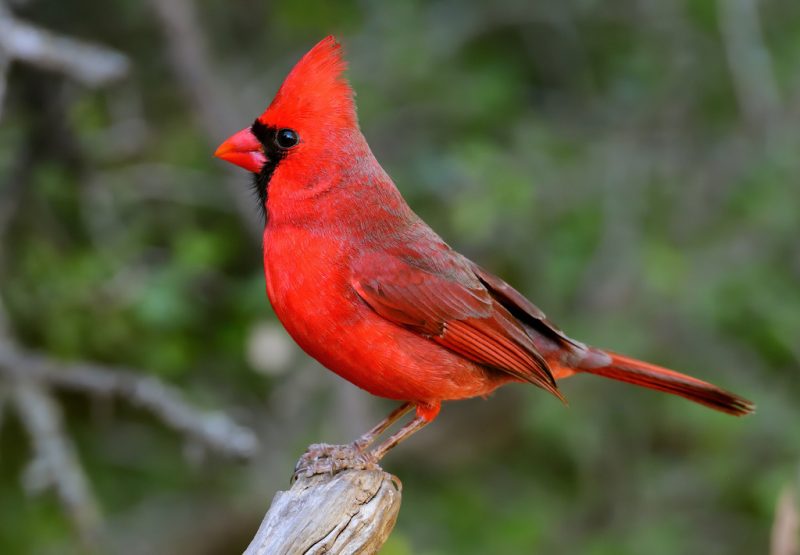The Northern Cardinal is one of the most beloved birds in North America, and in Arkansas, it holds a special place in the hearts of bird watchers and nature enthusiasts alike. With its striking red plumage and beautiful melodic song, the cardinal is easy to spot and even easier to love. This guide provides a comprehensive look into cardinals in Arkansas, covering everything from their behavior and habitat to identification tips and how to attract them to your backyard.
Arkansas’s varied landscapes, from forests and woodlands to suburban backyards and city parks, offer an ideal environment for cardinals to thrive. These non-migratory songbirds are a year-round presence, delighting residents and visitors with their beauty and song. Whether you’re an experienced birder or just beginning your birdwatching journey, understanding the habits and needs of the Northern Cardinal will enhance your appreciation for this iconic species.
In this complete guide, we’ll explore how to identify cardinals, where to find them in Arkansas, what they eat, how they behave, and the best ways to attract them to your outdoor space. You’ll also discover some fascinating facts about their breeding habits and the vital role they play in the ecosystem.
Identifying Cardinals in Arkansas

Physical Characteristics
The Northern Cardinal is one of the most easily recognized birds in North America. Males are known for their brilliant red feathers, a tall crest on their heads, and a distinctive black mask around their face that extends from the beak to the throat. Their bright orange-red beaks add to their striking appearance.
Female cardinals, while more muted in color, are equally charming. They exhibit soft brown plumage with warm red accents on the crest, wings, and tail. Their beaks are also orange-red, and they possess the same black facial mask, although it is less pronounced than in males.
Juvenile cardinals resemble females in coloration but may appear slightly duller. Their beaks tend to be darker until they mature. Both male and female cardinals measure about 8 to 9 inches in length with a wingspan of 10 to 12 inches.
Vocalizations
One of the defining traits of cardinals is their song. Both males and females sing, a behavior uncommon in many songbird species. Their calls are a series of clear whistles, often described as “cheer, cheer, cheer” or “birdie, birdie, birdie.” Cardinals use their songs to establish territory, attract mates, and communicate with one another.
Habitat and Distribution in Arkansas
Where They Live
Cardinals are highly adaptable and can be found across all regions of Arkansas. They thrive in a range of environments, including deciduous forests, woodland edges, shrublands, farmlands, and suburban neighborhoods. Cardinals prefer areas with dense foliage for nesting and open spaces for foraging.
They are most commonly seen perched in trees, hopping across lawns, or flitting through shrubs. Their year-round presence makes them a reliable sight in backyards and natural areas throughout the state.
Regional Sightings
From the Ozark Mountains in the north to the Mississippi Alluvial Plain in the east and the Ouachita Mountains in the west, cardinals are abundant in every corner of Arkansas. Birding hotspots like the Arkansas River Valley, Lake Ouachita, and Hot Springs National Park often report frequent cardinal sightings. Their vibrant color makes them stand out even in dense vegetation, especially in winter months when other birds are scarce.
Behavior and Daily Activity
Feeding Habits
Cardinals are primarily seed eaters, and their strong, cone-shaped beaks are well-suited for cracking open seeds. Their diet includes sunflower seeds, safflower seeds, and cracked corn. They also consume fruits such as berries and grapes, and occasionally insects, particularly during the breeding season.
Cardinals forage both in trees and on the ground. They tend to be more active in the early morning and late afternoon, when they are most frequently seen feeding. During colder months, their food sources become limited, making feeders an essential source of nutrition.
Social and Territorial Behavior
Cardinals are known for being territorial, especially during the breeding season. Males will defend their territory aggressively, often chasing away rivals or engaging in vocal contests to establish dominance. They have been observed attacking their own reflections in windows or mirrors, mistaking them for intruders.
Outside the breeding season, cardinals may join small flocks, particularly in the winter, and forage together. Despite their sometimes combative nature, they are generally non-aggressive toward humans and can become accustomed to regular human presence.
Breeding and Nesting
Mating and Courtship
Cardinals form monogamous pairs, and many remain with the same mate year after year. Courtship involves the male feeding the female in a behavior known as “mate feeding,” which helps strengthen their bond. The male also sings to attract the female and establish territory.
Mating season typically begins in early spring and can extend into late summer. In Arkansas, this means breeding may start as early as March and continue through August. Some pairs may raise two or even three broods per season.
Nest Construction and Eggs
Females are primarily responsible for building the nest, usually within dense shrubs or trees between 3 to 10 feet off the ground. The nest is cup-shaped and constructed from twigs, bark, grass, and leaves.
A typical clutch consists of 2 to 5 eggs, which are pale blue or greenish with brown speckles. The female incubates the eggs for about 11 to 13 days, during which the male provides food. Once hatched, both parents share in feeding the chicks until they fledge approximately 10 days later.
How to Attract Cardinals to Your Yard
Ideal Feeders and Food
Cardinals prefer stationary feeders, such as hopper, platform, or tray feeders, which provide ample space for them to perch. Hanging feeders with small perches are less appealing due to their size and balance requirements.
To attract cardinals, fill feeders with black-oil sunflower seeds, safflower seeds, or a seed mix formulated specifically for cardinals. During the warmer months, offering fresh fruit such as grapes or apple slices can also entice them.
Creating a Bird-Friendly Habitat
Providing shelter is key to attracting and retaining cardinals. Planting native shrubs, evergreens, and thickets offers them cover from predators and harsh weather. Dense foliage is especially important for nesting and roosting.
Birdbaths or shallow water sources are another major draw. Cardinals need water for drinking and bathing, and a clean, reliable water source will make your yard more attractive. Consider placing birdbaths near shrubs or trees where birds can quickly take cover.
Avoiding the use of pesticides and keeping outdoor cats indoors will also increase the safety of your yard, encouraging cardinals and other wildlife to visit frequently.
Seasonal Changes and Cardinal Activity
Winter Behavior
In winter, cardinals become even more visible against snow-covered landscapes, making them a favorite among birdwatchers during the colder months. Since food sources are scarce, they rely more heavily on feeders. They may also form small flocks, often made up of family members or other non-breeding cardinals.
Their vocalizations remain strong throughout the season, and it’s common to hear them singing even on cold mornings. Their presence during the winter months adds color and activity to otherwise quiet, dormant gardens.
Spring and Summer
Spring marks the start of breeding season, and cardinals become highly territorial. Males are frequently seen singing from high perches and defending their nesting areas. During this time, backyard sightings may become less frequent as birds spend more time in secluded nesting spots.
By summer, fledglings begin to leave the nest and may accompany parents to feeders. Their muted plumage can make them harder to identify at first, but they quickly develop the behavior and patterns of adult cardinals.
Importance of Cardinals in the Ecosystem
Cardinals play a significant role in their ecosystems. As seed dispersers, they help maintain plant diversity and regeneration in forests and fields. Their appetite for insects also aids in natural pest control, reducing the need for chemical treatments.
Their presence serves as an indicator of environmental health. Areas that support a healthy population of cardinals typically feature abundant native plants, clean water, and balanced insect populations. Supporting cardinals through conservation and habitat protection benefits countless other species as well.
In cultural and symbolic contexts, cardinals often represent hope, vitality, and the presence of loved ones. Their striking appearance and year-round presence have made them subjects of countless paintings, songs, and poems.
Frequently Asked Questions About Cardinals in Arkansas
Are cardinals common in Arkansas?
Yes, Northern Cardinals are extremely common across Arkansas. They are non-migratory and can be seen year-round in forests, parks, gardens, and backyards. Their bright red plumage and distinctive song make them easy to identify and a favorite among bird lovers throughout the state.
What do cardinals eat in Arkansas?
Cardinals primarily eat seeds, fruits, and insects. In Arkansas, they commonly feed on sunflower seeds, safflower seeds, berries, and small insects. Providing these foods in feeders can help attract them to your yard, especially during the winter months.
How do I attract cardinals to my backyard?
To attract cardinals, use platform or tray feeders filled with black-oil sunflower or safflower seeds. Planting dense shrubs and native vegetation provides shelter and nesting spots. A birdbath with clean water is also helpful, as cardinals need water year-round for drinking and bathing.
When is the best time to see cardinals in Arkansas?
Cardinals are visible throughout the year, but they are especially active during the early mornings and late afternoons. In winter, their bright red feathers contrast beautifully with the snowy landscape, making them easier to spot. Spring and summer are good for observing breeding behaviors and listening to their songs.
Do male and female cardinals look different?
Yes. Male cardinals are vibrant red with a black mask around the beak, while females are brown with red highlights on the wings, tail, and crest. Both have a similar body shape and orange-red beaks, but the female’s colors are more subdued for camouflage, especially during nesting.
Do cardinals migrate from Arkansas in winter?
No, cardinals are non-migratory birds. They stay in Arkansas year-round and do not travel long distances. During winter, they rely more on feeders and sheltered areas for food and warmth.
Where do cardinals nest in Arkansas?
Cardinals typically nest in dense shrubs, small trees, or thick vegetation. They prefer spots 3 to 10 feet off the ground with good cover to protect their eggs from predators. Females build the nest and may raise multiple broods each season, especially in Arkansas’s long breeding period from spring through summer.
Final Thoughts
The Northern Cardinal is more than just a beautiful bird—it’s a symbol of Arkansas’s rich natural heritage. Its vivid color, cheerful song, and familiar presence make it a cherished part of local ecosystems and a favorite among bird lovers.
Whether you’re enjoying their melodies at dawn, observing their nesting behavior, or simply appreciating their beauty from a kitchen window, cardinals offer endless opportunities for connection with the natural world. By learning about their needs and supporting their habitat, you not only attract these vibrant birds to your space but also contribute to the broader health of Arkansas’s wildlife.
Let this guide be your starting point in discovering the joys of cardinals in Arkansas. With the right approach and a little patience, you’ll find yourself welcoming these feathered friends into your daily life all year round.






